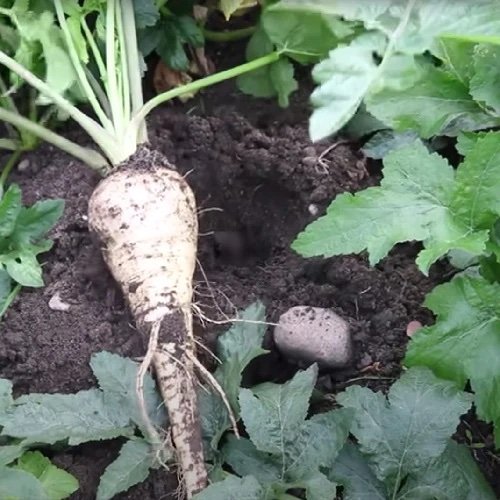Guernsey Longhorn Parsnips
Scientific Name: Pastinaca sativa 'Guernsey Longhorn'
Flavour: Guernsey Longhorn Parsnips have a sweet, nutty, and earthy flavor. They offer a distinctively rich and aromatic taste that is highly prized in culinary dishes.
Growing Season: Guernsey Longhorn Parsnips are typically grown as a winter vegetable and have a long growing season. They are sown in spring or early summer and harvested after the first frost, usually in late autumn or early winter.
Native Region: The parsnip, Pastinaca sativa, is native to Eurasia. While the specific variety 'Guernsey Longhorn' may not have a specific native region, parsnips in general have been cultivated and enjoyed in various regions around the world, including the British Isles.
Traditional Recipe: Roasted Guernsey Longhorn Parsnips
Ingredients:
Guernsey Longhorn parsnips, peeled and cut into even-sized pieces
Olive oil
Salt and pepper to taste
Fresh rosemary or thyme sprigs (optional)
Instructions:
Preheat the oven to 200°C (400°F).
Place the parsnip pieces on a baking sheet and drizzle with olive oil.
Sprinkle with salt and pepper to taste and toss to coat the parsnips evenly.
If desired, add fresh rosemary or thyme sprigs to the baking sheet for added flavor.
Spread the parsnips out in a single layer on the baking sheet.
Roast in the preheated oven for about 25-30 minutes, or until the parsnips are golden brown and tender when pierced with a fork.
Remove from the oven and serve the roasted parsnips as a delicious side dish or accompaniment to your main course.
Health Properties: Guernsey Longhorn Parsnips, like other parsnip varieties, are a good source of dietary fiber, vitamin C, and potassium. They also contain antioxidants and other beneficial plant compounds. Parsnips are known for their potential digestive health benefits and contribute to a balanced and nutritious diet.
Growing Technique:
Location: Guernsey Longhorn Parsnips thrive in full sun but can tolerate partial shade. They prefer well-drained soil that is rich in organic matter.
Planting: Sow the parsnip seeds directly into the ground in spring or early summer, when the soil has warmed up. Make sure to provide enough spacing between the seeds or seedlings, usually about 15-20 centimeters apart.
Maintenance: Keep the soil consistently moist during the germination period, but avoid overwatering. Once the parsnips have established, water them deeply and infrequently to encourage healthy root development. Mulching around the plants can help retain moisture and suppress weed growth.
Thinning: When the seedlings are about 10 centimeters tall, thin them out to ensure proper spacing and avoid overcrowding. Thin the plants to about 15-20 centimeters apart.
Soil Care: Parsnips benefit from loose and well-worked soil. Consider loosening the soil around the plants to prevent forking and allow the roots to grow straight and deep.
Pest and Disease Control: Keep an eye out for common pests such as carrot fly or aphids. Practice crop rotation and consider using physical barriers or organic pest control methods to protect the plants. Proper garden hygiene and healthy soil can help prevent disease issues.
Harvesting: Guernsey Longhorn Parsnips are typically ready for harvest after the first frost, as the cold temperatures enhance their flavor and sweetness. Gently loosen the soil around the parsnips and carefully lift them out of the ground using a garden fork or spade.
Storage: Once harvested, brush off any excess soil and store the parsnips in a cool, dark, and dry place. They can be stored in a cellar, refrigerator, or similar conditions for several weeks.
